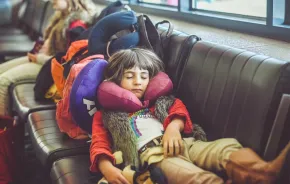
Photo:
A two-bed cabin at the new Getaway Skagit Valley outpost. Credit: Natasha Dillinger
After my family’s camper-van road trip this past summer, I’ve grown more interested in tiny-space vacations. Space limitations seem to encourage us to get out and explore our destination — while also providing a cozy home base for relaxing after a day out.
When I heard the lodging company Getaway was opening its latest outpost nearby — Getaway Skagit Valley in Mount Vernon, Wash., — I pounced on a stay.
Getaway’s formula is this: It offers unplugged tiny-cabin stays at 16 (and counting) outposts located across the U.S. Each outpost is made up of a collection of cabins, spaced out from one another, and the outposts are generally positioned within a couple hours’ drive of major cities.

An outpost that’s not too far out
For our visit to Getaway Skagit Valley, I appreciated that we were only about an hour north of Seattle — I didn’t want to spend half of our weekend trip on a marathon drive! Getaway’s Portland outpost is actually in Washington, but it’s near Mount Adams and about a 4.5-hour drive from Seattle.
For past family vacations, we’ve alternated among rental homes, an occasional hotel stay and cabins, both rustic and lux, so I had a lot of comparison points for this trip. The Skagit outpost’s 36 cabins are about 200 square feet in size and offer a blend of the features you’d find at more traditional accommodations: a hotel’s comfortable beds and private bathroom, a cabin’s natural setting and distance from noisy neighbors, and a mini version of a vacation rental’s indoor kitchen and dining space.
Getaway offers cabins with one bed or two.
Getaway amenities
For us tech-reliant city dwellers, we found plenty of amenities to help us put down our phones and enjoy our surroundings. Books and card decks share shelf space with an outpost-specific brochure with a map and activities (like conversation prompts and games to play). A fire pit and complimentary s’mores kit help to add some hygge to chilly nights.

We didn’t cook three-course meals, but our cabin’s mini-fridge and two-burner stove made it easy to whip up eggs and coffee for breakfast. All the dishware we needed for simple meals was provided.
The cabins have climate control and are even remarkably sound-proof. I had hoped the babbling creek right outside would add white noise to help my kids sleep, but we couldn’t hear a peep once the door was closed. Needless to say, we also didn’t hear any of the neighbors whose cabins were 100 feet away.
A signature feature of Getaway’s cabins is a huge picture window that allows you to enjoy your nature surroundings from inside.

Good for young kids
Our cabin was a good fit for our family’s current stage of life: My two-year-old and five-year-old are small enough to share a bed and enjoy the novelty of a loft, but also confident climbers who didn’t struggle on the narrow stairs to the upper bed.
We also tend to vacation on our own, without a large crew of families. Getaway’s cabins are far enough away from each other that vacationing in a group might present a challenge. Also the vibe is more “cozy” than “active,” so loud noises (yelling, playing music outdoors, etc.) are discouraged. Our kids felt welcome, but it was definitely not the same as a state park campground where we see packs of kids gleefully shouting at each other as they ride their bikes around the loop.

Things to do at this all-season destination
Perhaps best known for the annual Tulip Festival in April, the mild climate of the Skagit Valley makes it a great destination year-round. We found plenty of free or low-cost fun on our winter getaway and found that shopkeepers had more time to chat outside of the busiest season. You’ll also find plenty to do in the fall, including pony rides and more flowers!
With rain in the forecast for our first morning, we spent a little extra time in the car heading out to the Skagit River Bald Eagle Interpretive Center (free and open weekends, 10 a.m.–4 p.m., typically through mid-February), where a late salmon run brings in bald eagles looking to fatten up. This small but mighty volunteer-run center provides a few educational exhibits (including a nest replica), but the biggest draw is their free tours during the winter season. We took a leisurely and muddy walk along the river with Joe Ordonez, whose 35 years of experience as a naturalist helped us connect relationships between salmon, the forest and the eagles.

After a short picnic lunch, we headed to catch the last opening hour at the Padilla Bay Reserve’s Interpretive Center (free and open Wednesday–Saturday, 10 a.m.–4 p.m.). There are kid-friendly trails nearby, but some of our boots had sprung a leak and we were in search of a warm and dry nature experience.
Interactive exhibits help kids understand the unique estuary environment (where salt and fresh water mix), but make sure you save room for the aquarium in the back. We found an eelgrass tunnel and floor-to-ceiling tank with sea stars, wolf eels and crabs that vie with the “wow factor” you’d experience at the larger and more expensive Seattle Aquarium. The center was fairly empty during our visit and we got to chat with one of the aquarists as he fed baby sculpin fish that he has raised since they were zooplankton.

We reheated soup for dinner at our cabin before heading out to La Conner’s Conner Waterfront Park where we said hello to Carkeek Park’s salmon slide twin!
To minimize dish duty on our checkout morning, we headed to Beaver Tales Coffee for our hit of caffeine. This cozy spot is run by Fred Bell and his wife, Michelle (Molly) Calvin. They are members of the Alaskan Tlingit tribe (Michelle was adopted into the tribe) and the shop’s decor shares personal touches from their culture with the community. (Fun fact: Fred and Michelle are friends with the writers of the popular PBS show, Molly of Denali).

It was hunting season, which limited the bird-watching locations we felt comfortable with, but we managed to cap off the trip with a short walk at the Fir Island Farms Reserve. Our getaway was full of cozy family moments and opportunities to experience nature, so spotting a bald eagle in its nest looking over flocks of snow geese on the water felt like the perfect time to say “see you later” to the Skagit Valley.
If you go ...Find it: The Getaway Skagit Valley outpost is located at 21802 WA-9 in Mount Vernon, about an hour’s drive north of Seattle, near Lake McMurray. There is also a Portland outpost located at 24 Mount Adams Highway in Glenwood, Wash., about 4.5 hours from Seattle and 2 hours from Portland. Cost: Nightly rates vary widely and start at $149 for select weeknights, up to $299–$329 for weekend nights. A two-night stay is required for weekend stays. Dogs are welcome for a $40 per-stay fee. Provided supplies: Linens, basic kitchen and bath supplies and a s’mores kit are provided. Bring your own food and firewood, or purchase basic provision packs onsite. Facilities: Each cabin has its own flush toilet and hot shower. More fun in the Skagit Valley: |











